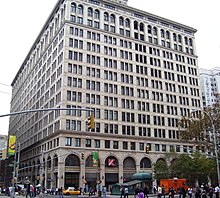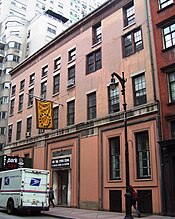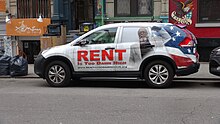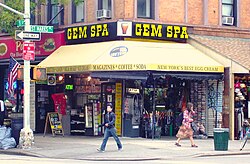Saint Marks Place
St. Mark's Place is considered a main cultural street for the East Village. Vehicular traffic runs east along both one-way streets. St. Mark's Place features a wide variety of retailers. Venerable institutions lining St. Mark's Place have included Gem Spa and the St. Mark's Hotel. There are several open-front markets that sell sunglasses, clothing, and jewelry. In her 400-year history of St. Mark's Place (St. Marks Is Dead), Ada Calhoun called the street "like superglue for fragmented identities" and wrote that "the street is not for people who have chosen their lives ... [it] is for the wanderer, the undecided, the lonely, and the promiscuous."
History
Early years
Wouter van Twiller, colonial governor of New Amsterdam, once owned a tobacco farm near 8th and MacDougal Streets. Such farms were located around the area until the 1830s. Nearby, a Native American trail crossed the island via the rights-of-way of Greenwich Avenue, Astor Place, and Stuyvesant Street.
The Commissioners' Plan of 1811 defined the street grid for much of Manhattan. According to the plan, 8th Street was to run from Greenwich Lane (now Greenwich Avenue) in the west to First Avenue on the east. The area west of Greenwich Lane was already developed as Greenwich Village, while the area east of First Avenue was reserved for a wholesale food market.
The plan was amended many times as the grid took shape and public spaces were added or eliminated. The marketplace proposal was scrapped in 1824, allowing 8th Street to continue eastward to the river. On the west side, Sixth Avenue was extended and Greenwich Lane shortened, shifting the boundary of 8th Street, ever so slightly, to Sixth Avenue and allowing Mercer, Greene, Wooster and MacDougal Streets to continue northward to 8th.
19th century
After the Commissioners' Plan was laid out, property along the street's right of way quickly developed. By 1835, the New York University opened its first building, the Silver Center, along Eighth Street near the Washington Square Park. Row houses were also built on Eighth Street. The street ran between the Jefferson Market, built in 1832 at the west end, and the Tompkins Market, built in 1836, at the east end. These were factors in the street's commercialization in later years.
Eighth Street was supposed to extend to a market place at Avenue C, but that idea never came to fruition. Capitalizing on the high-class status of Bond, Bleecker, Great Jones, and Lafayette Streets in NoHo, developer Thomas E. Davis developed the east end of the street and renamed it "St. Mark's Place" in 1835. Davis built up St. Mark's Place between Third and Second Avenues between 1831 and 1832. Although the original plan was for Federal homes, only three such houses remained in 2014.
Meanwhile, Eighth Street became home to a literary scene. At Astor Place and Eighth Street, the Astor Opera House was built by wealthy men and opened in 1847. Publisher Evert Augustus Duyckinck founded a private library at his 50 East Eighth Street home. Anne Lynch started a famous literary salon at 116 Waverly Place and relocated to 37 West Eighth Street in 1848. Around this time and up until the 1890s, Eighth Street was co-named Clinton Place in memory of politician DeWitt Clinton, whose widow lived along nearby University Place.
In the 1850s, Eighth Street housed an educational scene as well. The Cooper Union for the Advancement of Science and Art, a then-free institution for art, architecture and engineering education, was opened in 1858. The Century Club, an arts and letters association, relocated to 46 East Eighth Street around that time; the Bible House of the American Bible Society, was nearby. In addition, the Brevoort Hotel, as well as a marble mansion built by John Taylor Johnston, were erected at Fifth Avenue and Eighth Street.
At the same time, German immigrants moved into the area around Tompkins Square Park. The area around St. Mark's Place was nicknamed Kleindeutschland, or "Little Germany", because of a huge influx of German immigrants in the 1840s and 1850s. Many of the homes turned into boarding houses, as the area had 50,000 residents but not a lot of real estate. Tenement housing was also built on St. Mark's Place.
By the 1870s, apartments replaced stables and houses along the stretch of Eighth Street west of MacDougal Street. The elevated Third and Sixth Avenue Lines were also built during that time, with stops along the former at Ninth Street and along the latter at Eighth Street.

At the southwest corner of Broadway and Eighth Street, the street's first commercial building was built. By the 1890s, buildings on the stretch from Bowery to Fifth Avenue were used for trade. In 1904, the Wanamaker's Department Store opened at the former A.T. Stewart store along Broadway between 9th and 10th Streets, with an annex built at Eighth Street.
20th century
In the early 1900s, Little Germany was shrinking. At the same time, Jews, Hungarians, Poles, Ukrainians, and Russians from Eastern Europe started moving in. In 1916, members of the Slovenian community and Franciscans established the Slovenian Church of St. Cyril, which still operates. At this point, St. Mark's Place was considered a part of the Lower East Side.
On the western stretch of Eighth Street, an art scene was growing. Gertrude Vanderbilt Whitney, Daniel Chester French, and other artists moved in the stables at MacDougal Alley at this time. By 1916, a studio complex for artists replaced most of these stables, making the areas around Eighth Street popular for bohemians. Whitney, a patron for other American painters, combined four houses on West Eighth Street houses into the Whitney Museum in 1931.
The 1927 construction of the skyscraper at One Fifth Avenue, as well as the Eighth Street Playhouse movie theater, helped influence development on the Sixth Avenue end of the street, where construction of the IND Eighth Avenue Line had required destruction of many buildings there. On an adjoining block, the Women's House of Detention was built in Jefferson Market complex in 1929–1932 and existed through the 1970s.
In the 1930s, after Prohibition ended, West Eighth Street became an entertainment area. Around that time, the New York School movement for abstract expressionist painters was centered around Eighth Street, with many such painters moving to Eighth Street.
After World War II, property along 8th Street was converted to apartment houses. The Rhinelander Estate, one of the major landowners on Eighth Street, erected a building between Washington Square North, Fifth Avenue, West Eighth Street, and the Whitney Museum site. Sailor's Snug Harbor, the other major land owner, demolished the blocks from Fifth Avenue to Broadway on the north side of Eighth and Ninth Streets, including the popular Brevoort Hotel. It replaced these blocks mainly with low-rise apartment buildings and stores, as well as two high-rises. Around this time, West Eighth Street was also becoming the location of neighborhood commerce.
After the elevated train lines were demolished in the 1940s and 1950s, the real estate industry tried to entice residents to the St. Mark's Place area, describing the neighborhood as "East Village". This area became home to an underground scene, and as it was far from public transportation, it became rundown. A 1965 Newsweek article described the East Village by telling readers to "head east from Greenwich Village, and when it starts to look squalid, around the Bowery and Third Avenue, you know you're there."
In the 1960s, Macdougal and West Eighth Streets, as well as St. Mark's Place, became a popular area for hippies. A women's clothing store, a pharmacy, and bookstores were replaced by fast food restaurants and other shops, directed toward the area's tourism base. By 1968, St, Mark's Place became a stopping point for tour buses, which formerly skipped the area.
In 1977, St. Marks Place became the epicenter of punk rock, when Manic Panic opened its doors on July 7, 1977 (7/7/77). The shop quickly attracted musicians from Cyndi Lauper to the Ramones.
In 1980, hot dog company Nathan's Famous moved into the location of a former bookstore on Eighth Street, to the anger of some Greenwich Village residents. However, other establishments, such as the B. Dalton bookstore, clothing stores, and shoe stores, started to attract tourists to the area. By the 1990s, the areas around both Eighth Street and St. Mark's Place were becoming rapidly gentrified, with new buildings and establishments being developed along both streets. The Village Alliance Business Improvement District was formed in 1993 to care for the area around Eighth Street.





